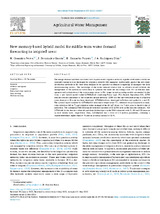Mostrar el registro sencillo del ítem
New memory-based hybrid model for middle-term water demand forecasting in irrigated areas
| dc.contributor.author | González Perea, R. | |
| dc.contributor.author | Fernández García, I. | |
| dc.contributor.author | Camacho Poyato, Emilio | |
| dc.contributor.author | Rodríguez-Díaz, Juan Antonio | |
| dc.date.accessioned | 2023-11-21T11:26:27Z | |
| dc.date.available | 2023-11-21T11:26:27Z | |
| dc.date.issued | 2023 | |
| dc.identifier.uri | http://hdl.handle.net/10396/26233 | |
| dc.description.abstract | The energy demand and their associated costs in pressurized irrigation networks together with water scarcity are currently causing serious challenges for irrigation district’s (ID) managers. Additionally, most of the new water distribution networks in IDs have been designed to be operated on-demand complexing ID managers the daily decision-making process. The knowledge of the water demand several days in advance would facilitate the management of the system and would help to optimize the water use and energy costs. For an efficient management and optimization of the water-energy nexus in IDs, longer term forecasting models are needed. In this work, a new hybrid model (called LSTMHybrid) combining Fuzzy Logic (FL), Genetic Algorithm (GA), LSTM encoder-decoder and dense or full connected neural networks (DNN) for the one-week forecasting of irrigation water demand at ID scale has been developed. LSTMHybrid was developed in Python and applied to a real ID. The optimal input variables for LSTMHydrid were mean temperature (°C), reference evapotranspiration (mm), solar radiation (MJ m−2) and irrigation water demand of the ID (m3) from 1 to 7 days prior to the first day of prediction. The optimal LSTMHybrid model selected consisted of 50 LSTM cells in the encoder submodel, 409 LSTM cells in the decoder submodel and three hidden layers in the DNN submodel with 31, 96 and 128 neurons in each hidden layer, respectively. Thus, LSTMHybrid had a total of 1.5 million parameters, obtaining a representativeness higher than 94 % and an accuracy around of 20 %. | es_ES |
| dc.format.mimetype | application/pdf | es_ES |
| dc.language.iso | eng | es_ES |
| dc.publisher | Elsevier | es_ES |
| dc.rights | https://creativecommons.org/licenses/by-nc-nd/4.0/ | es_ES |
| dc.source | González Perea, R., Fernández García, I., Camacho Poyato, E., & Rodríguez Díaz, J. (2023). New memory-based hybrid model for middle-term water demand forecasting in irrigated areas. Agricultural Water Management, 284, 108367. https://doi.org/10.1016/j.agwat.2023.108367 | es_ES |
| dc.subject | Artificial intelligence | es_ES |
| dc.subject | Irrigation | es_ES |
| dc.subject | Pressurized water networks | es_ES |
| dc.subject | Deep learning | es_ES |
| dc.subject | Machine learning | es_ES |
| dc.title | New memory-based hybrid model for middle-term water demand forecasting in irrigated areas | es_ES |
| dc.type | info:eu-repo/semantics/article | es_ES |
| dc.relation.publisherversion | https://doi.org/10.1016/j.agwat.2023.108367 | es_ES |
| dc.relation.projectID | Gobierno de España. PID2020-115998RB-C2 | es_ES |
| dc.relation.projectID | Gobierno de España. CEX2019-000968-M | es_ES |
| dc.rights.accessRights | info:eu-repo/semantics/openAccess | es_ES |

